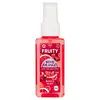What's inside
What's inside
 Key Ingredients
Key Ingredients

 Benefits
Benefits

 Concerns
Concerns

 Ingredients Side-by-side
Ingredients Side-by-side

Water
Skin ConditioningParfum
MaskingGlycerin
HumectantGlycereth-7 Trimethyl Ether
Skin ConditioningHydroxyacetophenone
AntioxidantAcer Saccharum Extract
Skin ConditioningCitrullus Lanatus Fruit Extract
Skin ConditioningCitrus Aurantium Dulcis Fruit Extract
MaskingCitrus Limon Fruit Extract
MaskingFragaria Vesca Fruit Extract
AstringentSaccharum Officinarum Extract
MoisturisingVaccinium Angustifolium Fruit Extract
Skin ProtectingVaccinium Myrtillus Fruit Extract
Skin ConditioningPhenoxyethanol
PreservativeAloe Barbadensis Leaf Juice
Skin ConditioningBenzaldehyde
MaskingBenzyl Alcohol
PerfumingLinalool
PerfumingRose Ketone-4
PerfumingTetramethyl Acetyloctahydronaphthalenes
MaskingVanillin
MaskingSodium C14-16 Olefin Sulfonate
CleansingCocamidopropyl Hydroxysultaine
CleansingSodium Chloride
MaskingAcrylates Crosspolymer-4
Emulsion StabilisingSodium Cocoyl Glutamate
CleansingCitric Acid
BufferingSodium Hydroxide
BufferingPolyquaternium-73
Sodium Benzoate
MaskingIsopropyl Alcohol
SolventPropanediol
SolventMagnolia Officinalis Bark Extract
AntimicrobialHexamethylindanopyran
MaskingCaprylic/Capric Triglyceride
MaskingCetyl Alcohol
EmollientStearic Acid
CleansingGlyceryl Stearate
EmollientPEG-100 Stearate
Helianthus Annuus Seed Oil
EmollientIsopropyl Myristate
EmollientOlea Europaea Fruit Oil
MaskingPersea Gratissima Oil
Skin ConditioningButyrospermum Parkii Butter
Skin ConditioningMica
Cosmetic ColorantCarbomer
Emulsion StabilisingPotassium Sorbate
PreservativeCocos Nucifera Oil
MaskingCI 77891
Cosmetic ColorantWater, Parfum, Glycerin, Glycereth-7 Trimethyl Ether, Hydroxyacetophenone, Acer Saccharum Extract, Citrullus Lanatus Fruit Extract, Citrus Aurantium Dulcis Fruit Extract, Citrus Limon Fruit Extract, Fragaria Vesca Fruit Extract, Saccharum Officinarum Extract, Vaccinium Angustifolium Fruit Extract, Vaccinium Myrtillus Fruit Extract, Phenoxyethanol, Aloe Barbadensis Leaf Juice, Benzaldehyde, Benzyl Alcohol, Linalool, Rose Ketone-4, Tetramethyl Acetyloctahydronaphthalenes, Vanillin, Sodium C14-16 Olefin Sulfonate, Cocamidopropyl Hydroxysultaine, Sodium Chloride, Acrylates Crosspolymer-4, Sodium Cocoyl Glutamate, Citric Acid, Sodium Hydroxide, Polyquaternium-73, Sodium Benzoate, Isopropyl Alcohol, Propanediol, Magnolia Officinalis Bark Extract, Hexamethylindanopyran, Caprylic/Capric Triglyceride, Cetyl Alcohol, Stearic Acid, Glyceryl Stearate, PEG-100 Stearate, Helianthus Annuus Seed Oil, Isopropyl Myristate, Olea Europaea Fruit Oil, Persea Gratissima Oil, Butyrospermum Parkii Butter, Mica, Carbomer, Potassium Sorbate, Cocos Nucifera Oil, CI 77891
Ingredients Explained
These ingredients are found in both products.
Ingredients higher up in an ingredient list are typically present in a larger amount.
Glycerin is already naturally found in your skin. It helps moisturize and protect your skin.
A study from 2016 found glycerin to be more effective as a humectant than AHAs and hyaluronic acid.
As a humectant, it helps the skin stay hydrated by pulling moisture to your skin. The low molecular weight of glycerin allows it to pull moisture into the deeper layers of your skin.
Hydrated skin improves your skin barrier; Your skin barrier helps protect against irritants and bacteria.
Glycerin has also been found to have antimicrobial and antiviral properties. Due to these properties, glycerin is often used in wound and burn treatments.
In cosmetics, glycerin is usually derived from plants such as soybean or palm. However, it can also be sourced from animals, such as tallow or animal fat.
This ingredient is organic, colorless, odorless, and non-toxic.
Glycerin is the name for this ingredient in American English. British English uses Glycerol/Glycerine.
Learn more about GlycerinHydroxyacetophenone is antioxidant with skin conditioning and soothing properties. It also boosts the efficiency of preservatives.
This ingredient is not irritating or sensitizing.
Parfum is a catch-all term for an ingredient or more that is used to give a scent to products.
Also called "fragrance", this ingredient can be a blend of hundreds of chemicals or plant oils. This means every product with "fragrance" or "parfum" in the ingredients list is a different mixture.
For instance, Habanolide is a proprietary trade name for a specific aroma chemical. When used as a fragrance ingredient in cosmetics, most aroma chemicals fall under the broad labeling category of “FRAGRANCE” or “PARFUM” according to EU and US regulations.
The term 'parfum' or 'fragrance' is not regulated in many countries. In many cases, it is up to the brand to define this term.
For instance, many brands choose to label themselves as "fragrance-free" because they are not using synthetic fragrances. However, their products may still contain ingredients such as essential oils that are considered a fragrance by INCI standards.
One example is Calendula flower extract. Calendula is an essential oil that still imparts a scent or 'fragrance'.
Depending on the blend, the ingredients in the mixture can cause allergies and sensitivities on the skin. Some ingredients that are known EU allergens include linalool and citronellol.
Parfum can also be used to mask or cover an unpleasant scent.
The bottom line is: not all fragrances/parfum/ingredients are created equally. If you are worried about fragrances, we recommend taking a closer look at an ingredient. And of course, we always recommend speaking with a professional.
Learn more about ParfumPhenoxyethanol is a preservative that has germicide, antimicrobial, and aromatic properties. Studies show that phenoxyethanol can prevent microbial growth. By itself, it has a scent that is similar to that of a rose.
It's often used in formulations along with Caprylyl Glycol to preserve the shelf life of products.
Water. It's the most common cosmetic ingredient of all. You'll usually see it at the top of ingredient lists, meaning that it makes up the largest part of the product.
So why is it so popular? Water most often acts as a solvent - this means that it helps dissolve other ingredients into the formulation.
You'll also recognize water as that liquid we all need to stay alive. If you see this, drink a glass of water. Stay hydrated!
Learn more about Water